Although widely acclaimed as a country with a mathematics heritage stretching back to Aryabhatta and Ramanujan, there’s been a steady decline of students opting for maths higher education in post-independence India. Even the mathematical skills of 230 million children in primary-secondary education are in steep decline. Hemalatha Raghupathi reports
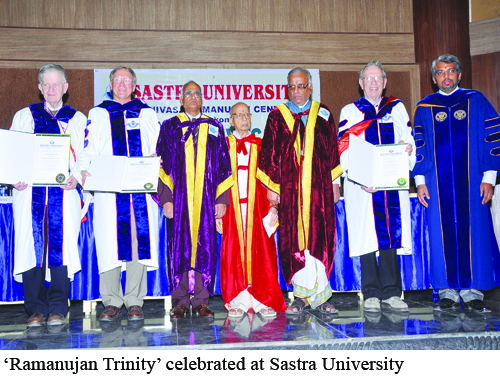 The temple town of Kumbakonam (pop.140,113) in Thanjavur district of Tamil Nadu was a hub of activity and excitement last December, when the year-long 125th birth anniversary celebrations of mathematical genius Srinivasa Ramanujan (1887-1920) drew to a close. Over 300 math scholars, professors and researchers from India and abroad including the three authorities on the works of Ramanujan, popularly known as the ‘Ramanujan Trinity’ — professors George Andrews of Pennsylvania State University, Richard Askey of the University of Wisconsin and Bruce Berndt of the University of Illinois — converged on his home town to attend an international conference titled ‘The Legacy of Ramanujan’, staged on the 160-acre campus of Sastra University on Dece-mber 14-15. To mark the occasion, the university which has been conducting Ramanujan-inspired annual math conferences since 2003, conferred D.Sc (honoris causa) degrees on the Ramanujan Trinity.
The temple town of Kumbakonam (pop.140,113) in Thanjavur district of Tamil Nadu was a hub of activity and excitement last December, when the year-long 125th birth anniversary celebrations of mathematical genius Srinivasa Ramanujan (1887-1920) drew to a close. Over 300 math scholars, professors and researchers from India and abroad including the three authorities on the works of Ramanujan, popularly known as the ‘Ramanujan Trinity’ — professors George Andrews of Pennsylvania State University, Richard Askey of the University of Wisconsin and Bruce Berndt of the University of Illinois — converged on his home town to attend an international conference titled ‘The Legacy of Ramanujan’, staged on the 160-acre campus of Sastra University on Dece-mber 14-15. To mark the occasion, the university which has been conducting Ramanujan-inspired annual math conferences since 2003, conferred D.Sc (honoris causa) degrees on the Ramanujan Trinity.
The quasquicentennial celebration wasn’t restricted to his hometown. Across India and abroad, there were celebrations with the Union government, Indian and foreign universities, and mathematical societies organising lectures, activities and programmes. In Delhi, the Indian Mathematical Society organised an international maths conference between December 17-22, at which it awarded the annual SASTRA Ramanujan Prize ($10,000) to Zhiwei Yun of Stanford University; a series of ‘mathematical panorama lectures’ were delivered countrywide by prominent mathematicians throughout last year; a biography of Ramanujan titled The Man Who Knew Infinity was released by Brooklyn-born science writer Robert Kanigel, and two books by well-known mathematician and Ramanujan scholar Alladi Krishnaswamy of the University of Florida. Moreover the Union govern-ment declared 2012 as the National Mathematics Year and December 22 as National Mathematics Day.
However these enthusiastic celebrations to honour India’s maths guru were also a time for introspection, soul-searching and anguish about the country’s rapidly declining mathematical prowess and proficiency. Inaugurating Ramanujan’s birth anniversary celebrations at Madras University, prime minister Manmohan Singh lamented that “for a country of our size, the number of competent mathematicians we have is badly inadequate”. “There is a general perception in our society that the pursuit of mathematics does not lead to attractive career possibilities. This perception must change as today there are many new career opportunities available to mathematicians… Mathe-matics has tremendous influence on every kind of human behaviour. In many ways mathematics can be regarded as the mother science. The natural sciences have had a long symbiotic relationship with mathematics. Mathematics has also influenced the study of social sciences in a big way,” he said, urging colleges and universities to discover and encourage mathematical talent.
Although widely acclaimed as a country with a mathematics heritage stretching back to Aryabhatta (476-550) who discovered the zero, there’s been a steady decline in the number of students opting for maths higher education in post-independence India. This has resulted in a huge shortage of math teachers in India’s 1.30 million primary-secondary schools, 611 univer-sities and 34,000 colleges. According to estimates, during the period 2010-12 there’s been a 50 percent decrease in students enroling for undergraduate degree programmes in maths and science. This number drips to a trickle in postgraduate and research education — in the period 2001-11 India produced only 5,766 research papers in mathe-matics (cf. China’s 36,146). Until recently a nation respected for its maths tradition and proficiency, currently India is ranked # 14 in the ‘Essential Science Indicators’ compiled by Thomson Reuters in terms of the number of math papers published in the past decade, and 22nd (China is ranked No. 2) in terms of citations (see box).
Math research papers
| Rank |
|
No of Papers |
| 1 |
United States |
78,874 |
| 2 |
China |
36,146 |
| 3 |
France |
26,377 |
| 9 |
Russia |
13,614 |
| 12 |
South Korea |
6,406 |
| 14 |
India |
5,766 |
| 15 |
Israel |
5,427 |
| 16 |
Brazil |
5,175 |
Source: Essential Science Indicators (Thomson Reuters)
Shockingly, even as India’s once vaunted math education capability in higher education and research is now history, the mathematical skills of 230 million children in primary and secondary education are in steep decline. The Annual Status of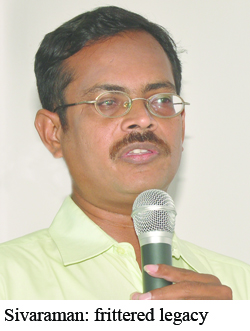 Education Report 2012, authored by the highly-respected NGO Pratham released on January 18, reveals that math learning outcomes in rural primaries in 570 districts countrywide are going from bad to worse. According to the report, in 2010, 29.1 percent of class V children couldn’t solve simple two-digit subtra-ction sums with borrowing. This disab-ility has shot to 39 percent in 2011 and 46.5 percent in 2012. Barring Andhra Pradesh, Karnataka and Kerala, every major state showed a substantial drop in arithmetic capability. The proportion of class V children who cannot do division sums too has increased from 72.4 percent in 2011 to 75.2 percent in 2012.
Education Report 2012, authored by the highly-respected NGO Pratham released on January 18, reveals that math learning outcomes in rural primaries in 570 districts countrywide are going from bad to worse. According to the report, in 2010, 29.1 percent of class V children couldn’t solve simple two-digit subtra-ction sums with borrowing. This disab-ility has shot to 39 percent in 2011 and 46.5 percent in 2012. Barring Andhra Pradesh, Karnataka and Kerala, every major state showed a substantial drop in arithmetic capability. The proportion of class V children who cannot do division sums too has increased from 72.4 percent in 2011 to 75.2 percent in 2012.
Yet the fact that the national decline in maths proficiency has not spared the southern seaboard state of Tamil Nadu (pop.72 million), which is widely acknowledged as the country’s most maths literate state, has taken Indians and Tamilians themselves by surprise. According to ASER 2012, which surveyed 22,844 households in 811 villages across the state, 58.5 percent of children in class III cannot manage simple subtraction sums and only 1.3 percent can manage division. Even in class V, 85 percent of children cannot solve simple division sums. The state’s higher education institutions too, have slipped into mediocrity. In 2012, nearly 60 percent of second-year students of several engin-eering disciplines at the highly reputed College of Engineering, Guindy, failed their math papers.
“I’m not surprised that math skills of students countrywide — Tamil Nadu included — are declining. Over the past three decades there’s been falling interest in math learning, teaching and research. This disinterest has seeped down to the school level where poorly qualified teachers use rote learning to teach maths. In rural government schools in the state, people with class XII qualifications are appointed teachers and in some schools one teacher teaches all subjects. Lack of competent teachers is exacerbated by the single-minded focus of schools, parents and teachers on exams and marks, rather than conceptual clarity and comprehension. This has had a disastrous effect on maths teaching-learning as the subject cannot be mastered by rote and memorisation. Moreover, Tamil Nadu is perhaps the only state to have scrapped all entrance exams to professional colleges — math skills and analytical thinking were critical for success in these exams. It’s tragic that by neglecting teacher training and dumbing down standards, Tamil Nadu has frittered away its centuries-old maths legacy,” laments Prof. R. Sivaraman, assistant professor of mathematics at D.G. Vaishnav College, Chennai, author of a 450-page Tamil language biography of Ramanujan and founder of the Pie Mathematics Associ-ation (estb. 2007), whose mission is to spark love of maths within school and college students. To this end the association has developed over 60 math models, 150 exclusive videos and 40 vinyl charts to explain complex mathematical concepts to students across the education spectrum — from primaries to postgraduates.
The sharp fall in math teaching-learning standards is by no means restricted to government and low-budget private schools for the poor. According to the Quality Education Study 2011 (QES) — a survey conducted by Bangalore-based IT major Wipro Ltd and Ahmedabad-based Educational Initiatives — India’s high-end metro-politan private schools don’t teach math much better. The study which assessed 23,000 students and 790 teachers in 89 English-medium private schools in Mumbai, Delhi, Chennai, Bangalore, and Kolkata found that the maths proficiency of class IV and VI students is way below international averages.
Class IV students scored lower than the international average in response to questions drawn from studies such as Trends in International Maths and Science Study (TIMSS) and Progress in Reading Literacy Study (PIRLS). A whopping 67 percent of students in class IV couldn’t answer a question about the length of a pencil placed against a ruler, while nearly half ofclasses IV, VI and VIII students said the shape of a square object would change if it is tilted.
How far down India’s maths learning capability has slipped from its formerly pristine position was cruelly exposed a year ago when after much coaxing and cajoling, a first batch of students from India wrote the global PISA (Programme for International Student Assessment) 2011 which tests the general maths, science and reading capabilities of 15-year-olds. Two batches of this age group from government and private schools in Tamil Nadu and Himachal Pradesh — states ranked 4 and 13 on the Education Development Index of the Delhi-based NUEPA (National University for Educational Planning & Administration) — wrote the test. The results were a national embarrassment: Indian students’ capabilities were ranked 73 (out of 74) — above only Kyrgyzstan, with students from China (Shanghai) topping all three categories.
“Deterioration in maths teaching-learning is not peculiar to Tamil Nadu, Himachal Pradesh or India; it’s a global phenomenon. In their haste to complete syllabuses and prepare children for exams, teachers are sacrificing compr-ehension and discouraging innovation. Children should be encouraged to appreciate and enjoy the symmetry and beauty of patterns, equations and exactitude of math subjects. They need to be taught imaginatively and innov-atively. For teachers to be able to do that, they must not only have subject expertise but should also have under-gone rigorous training in contemporary math teaching pedagogies. Colleges and universities have to take the responsibility of producing high-quality teachers for schools because that’s when young children become math-phobic which is carried forward into higher classes,” says well-known mathematician and Ramanujan scholar Dr. Alladi Krishnaswamy, professor, department of mathematics, University of Florida, who visits India twice every year to organise Sastra University’s annual mathematics conference, and is also chairperson of the Srinivasa Ramanujan Awards prize committee.
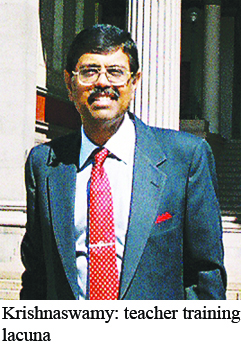 Decades of slapdash and forced teaching has induced maths phobia not only within student communities but also among teachers and parents. A dipstick survey conducted in Karnataka by Suvidya, a Bangalore-based NGO which builds low-cost math labs, indicates that most teachers and parents are intimidated by the subject, a phobia created by stern math teachers inflicting punishment, encouraging rote learning and practicing child-unfriendly pedagogies.
Decades of slapdash and forced teaching has induced maths phobia not only within student communities but also among teachers and parents. A dipstick survey conducted in Karnataka by Suvidya, a Bangalore-based NGO which builds low-cost math labs, indicates that most teachers and parents are intimidated by the subject, a phobia created by stern math teachers inflicting punishment, encouraging rote learning and practicing child-unfriendly pedagogies.
Somewhat belatedly, this phenomenon has set alarm bells ringing within education institutions and the middle class, which values maths proficiency as a prerequisite for success in science and technology careers. In particular within the country’s 80,000 private schools, there’s growing awareness of the need to innovate in maths teaching by going beyond monotonous textbooks and discovering experiential ways of teaching math subjects. Within the country’s benchmark 10,000 CBSE and 1,800 CISCE affiliated schools, appli-cations-oriented teaching through math labs, puzzles, games and even skits is replacing chalk-and-talk pedagogies.
S. Jayaram, principal of the CISCE-affiliated Valley School, Bangalore, ranked #2 nationally among day schools in the EducationWorld India School Rankings 2012, believes that within math classrooms of progressive schools there’s a shift from formulae memori-sation to practical teaching through puzzles, games, and other learning aids. “In the Valley School we don’t teach math subjects academically. We inte-grate them with everyday life situations, the arts and business, so that math-ematical concepts can be easily grasped and recalled. We use activities, games, puzzles and stories to teach math. School managements are becoming aware that experiential math teaching can sustain student interest and deliver better learning outcomes,” says Jayaram.
EducationWorld India School Rankings 2012, believes that within math classrooms of progressive schools there’s a shift from formulae memori-sation to practical teaching through puzzles, games, and other learning aids. “In the Valley School we don’t teach math subjects academically. We inte-grate them with everyday life situations, the arts and business, so that math-ematical concepts can be easily grasped and recalled. We use activities, games, puzzles and stories to teach math. School managements are becoming aware that experiential math teaching can sustain student interest and deliver better learning outcomes,” says Jayaram.
That slowly but surely math teaching-learning is experiencing a metamorphosis is demonstrated by the fact that over 12,000 schools have installed math labs to encourage experiential learning of math subjects. Several private entrep-reneurs and organisations have stepped into the breach to help schools install labs at comfortable price points varying from Rs.5,000-50,000.
Among them is Jodo Gyan, a Delhi-based not-for-profit which has installed over 5,000 math labs in schools countrywide. “A math lab is the first step towards shifting to activity-based teaching. It helps students and teachers learn new experiential ways of learning-teaching math. Our labs comprise two components: activities, games, puzzles and learning materials directly related to the curriculum, and Discovering Math-ematics which helps students exper-ience the intellectual joy of maths. The investment needed to set up maths labs is flexible — from Rs.10,000-50,000. We follow up our math labs with teacher workshops to help them integrate experiential pedagogies into school curriculums,” says A.K. Shaji, founder director of Jodo Gyan.
The idea of establishing math labs to put the fun back into maths learning has acquired some traction. In 2004 the Delhi-based CBSE — India’s largest secondary examinations board — issued a directive to all its affiliated schools to install math labs for students in classes III-VIII.
Comments Bhavani Bhaskar, vice principal and head of the department of mathematics at the CBSE-affiliated PSBB Millennium School, Chennai, which followed the directive and set up a math lab in 2005: “Math labs enable students to learn and explore math-ematical concepts using learning materials. They help in banishing math phobia. In PSBB Millennium we have also appointed a math lab teacher to conduct and monitor experiments. CBSE has suggested several math lab activities and 20 marks are allocated in the final exam for math lab experiments. Our students have greatly benefited from math experiments with conceptual comprehension and learning outcomes showing vast improvement.”
.jpg) While private schools are beginning to address the widening maths proficiency gap through innovative pedagogies, the panic generated by the flurry of studies highlighting the poor showing of Indian students in national and international math exams has also spawned a new generation of supplem-entary maths education companies which are using the abacus, vedic maths and traditional Indian games to cure maths phobia and put children at ease with numbers and numbers crunching. The big names among supplementary maths learning companies are Aloha India Pvt. Ltd, Chennai which teaches maths the abacus way to an estimated 110,000 students in 1,200 franchised centres across India; UCMas Mental Arithmetic, Chennai which offers abacus-based maths programmes to 700,000 students in 2,400 centres countrywide; and SIP Academy, Chennai which also provides abacus programmes through 540 learning centres with an enrolment of 45,000 students. The Chennai-based Ideal Play Abacus also runs 850 centres with 65,000 students.
While private schools are beginning to address the widening maths proficiency gap through innovative pedagogies, the panic generated by the flurry of studies highlighting the poor showing of Indian students in national and international math exams has also spawned a new generation of supplem-entary maths education companies which are using the abacus, vedic maths and traditional Indian games to cure maths phobia and put children at ease with numbers and numbers crunching. The big names among supplementary maths learning companies are Aloha India Pvt. Ltd, Chennai which teaches maths the abacus way to an estimated 110,000 students in 1,200 franchised centres across India; UCMas Mental Arithmetic, Chennai which offers abacus-based maths programmes to 700,000 students in 2,400 centres countrywide; and SIP Academy, Chennai which also provides abacus programmes through 540 learning centres with an enrolment of 45,000 students. The Chennai-based Ideal Play Abacus also runs 850 centres with 65,000 students.
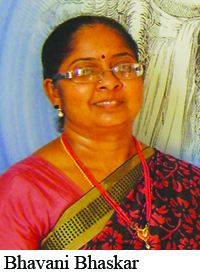 It’s not entirely coincidental that all these supplementary maths education companies offering out-of-school programmes have their head offices in Chennai — once the maths epicentre of India but now experiencing a sharp decline in teaching-learning standards. Quite clearly middle class parents in the state who appreciate that maths proficiency is critical to cracking all-India entrance exams such as IIT-JEE/CAT, success in which is the prereq-uisite of entry into the IITs and IIMs and best jobs in the newly emergent economy, have pressed the panic button. The mushroom growth of private sector maths education companies is the entrepreneurial response to this panic.
It’s not entirely coincidental that all these supplementary maths education companies offering out-of-school programmes have their head offices in Chennai — once the maths epicentre of India but now experiencing a sharp decline in teaching-learning standards. Quite clearly middle class parents in the state who appreciate that maths proficiency is critical to cracking all-India entrance exams such as IIT-JEE/CAT, success in which is the prereq-uisite of entry into the IITs and IIMs and best jobs in the newly emergent economy, have pressed the panic button. The mushroom growth of private sector maths education companies is the entrepreneurial response to this panic.
“Within the parents community of Tamil Nadu there’s growing fear that children are not getting a good found-ation in maths in schools. Consequently children find math subjects difficult and this phobia is carried into higher classes. The objective of SIP Academy is to use the abacus, which is essentially a beads calculator, to teach arithmetic. Children learn to mentally visualise the abacus and do fast cognitive calcul-ations using quick finger movements. We have found that at the end of a one-year foundation programme — one class a week — children’s skills and scores are five times better than what they were when they first enroled with us. We even refund the annual fee of Rs.5,000 to parents if promised skill improvement doesn’t happen,” says Dinesh Victor, the Chennai-based CEO of SIP Academy India Pvt. Ltd which has 540 franchised centres in 18 states countrywide. A highly qualified alum of IIT-Mumbai and IIM-Ahmedabad, Victor signed an agreement with SIP Academy SDN BHD, Malaysia and promoted its first Indian affiliate in Chennai in 2002. Since then SIP Academy has upskilled the maths proficiency of 225,000 children across the country.
Supplementary maths education companies which are rapidly expanding under the franchise model apart, other entrepreneurs are combining maths evangelism with business to improve learning outcomes of children. A case in point is the Chennai-based Ladder Education Services Pvt. Ltd (estb. 2009) which has developed several maths and science hands-on activities and a complete classroom kit to teach primary and high school students. “Our classroom kit and activities are designed to help teachers teach maths in practical and enjoyable ways. Currently over ten schools are using our kits and learning materials. We have also conducted over 100 workshops and trained over 1,000 teachers. The feedback from user schools is that student learning outcomes in maths have greatly improved,” says P. Suryakumar, founder-director of Ladder Education.
Changing attitudes towards maths teaching-learning in schools and the popularity of supplementary math education companies are directly related to parents and students’ enthusiasm to succeed in national and international science and engineering collegiate entrance examinations of premier institutions, rather by the desire to pursue maths higher education and research. The number of students opting for undergraduate degrees in maths in colleges across the country has reduced by 50 percent over the period 2010 -2012. Consequently, the Indian National Science Academy (INSA) has been struggling to get nominations for election of mathematics fellows, even as it receives a large number of nominations for physics, chemistry and the biological sciences.
are directly related to parents and students’ enthusiasm to succeed in national and international science and engineering collegiate entrance examinations of premier institutions, rather by the desire to pursue maths higher education and research. The number of students opting for undergraduate degrees in maths in colleges across the country has reduced by 50 percent over the period 2010 -2012. Consequently, the Indian National Science Academy (INSA) has been struggling to get nominations for election of mathematics fellows, even as it receives a large number of nominations for physics, chemistry and the biological sciences.
“During the period 1998-2002, very few students chose to pursue math-ematics beyond school even if they were especially talented in the subject, because of the information technology boom. The preference for engineering education has resulted in a huge shortage of math graduates, teachers and researchers. The main reason for shunning mathematics is the public misconception that there are few attractive career opportunities for math professionals. But with maths profi-ciency and expertise required in most industries, there is growing demand for people with strong analytical skills and a broad-based background in the mathematical sciences. Increasingly, corporations in advanced countries are employing pure math professionals in research units and as consultants, and Indian industry would do well to emulate their counterparts in the West. More-over, the acute shortage of math professors even in university depart-ments is very discouraging for young-sters committed to the study of math-ematics,” says distinguished mathem-atician and Padma Bhushan awardee Prof. M.S. Raghunathan, visiting prof-essor, department of mathematics and head, National Centre for Mathematics, IIT-Mumbai.
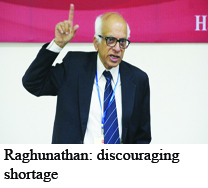 The grave shortage of maths faculty in higher education and research institutions is also attributable to the continuous brain drain of talented young Indian mathematicians to universities in the West, particularly the US during the past four decades. While Indian mathematicians are performing well abroad, there is a vacuum at the top in Indian mathematics. For three years (2010-2012), the Bangalore-based software major Infosys Technologies which has instituted a prize for outstanding mathematics research in India, could not find a sufficiently distinguished maths researcher working in an Indian institution for conferring the prize, and had to finally award an Indian mathematician working abroad.
The grave shortage of maths faculty in higher education and research institutions is also attributable to the continuous brain drain of talented young Indian mathematicians to universities in the West, particularly the US during the past four decades. While Indian mathematicians are performing well abroad, there is a vacuum at the top in Indian mathematics. For three years (2010-2012), the Bangalore-based software major Infosys Technologies which has instituted a prize for outstanding mathematics research in India, could not find a sufficiently distinguished maths researcher working in an Indian institution for conferring the prize, and had to finally award an Indian mathematician working abroad.
The main cause of the continuous brain drain is that unlike in the West where most universities have excellent math teaching and research departments, math faculties in Indian universities are pathetically under resourced and under staffed with research almost non-existent. Consequently student choice in maths higher education is restricted to the handful of government-funded research institutions such as the Indian Institute of Science, Bangalore and Tata Institute of Fundamental Research, Mumbai (see box).
Initiatives to popularise maths higher education and research among students and the public are few and far between. Among them is the Mathematics Training and Talent Search (MTTS) programme funded by the National Board for Higher Mathematics (NBHM) under which 120 undergrad and postgrad students mostly from rural India, are offered a four-week maths training programme. “Since 1993 the MTTS programme has been providing young undergraduate and postgrad students an excellent orientation in maths study and research at advanced levels. Moreover the country’s top maths research institutes offer very attractive fellowships to students at the postgrad and doctoral levels. But obviously we need more initiatives to encourage and develop new mathem-atical talent,” says Prof. Dr. Srinivas Kotyada, research scientist at the premier Institute of Mathematical Sciences (estb. 1962), Chennai. 
However, even as research facilities and incentives must be bettered to attract, develop and retain maths talent in higher education and research, a new begin-ning in maths teaching-learning also has to be made at the school level and in particular in the country’s 1.28 million government primary-secondaries. According to Prof. P.D. Srivastava, head, mathematics department, IIT-Kharagpur, the need of the hour is a “national level teacher training programme in math-ematics” which will train government school teachers in activity-based maths teaching-learning pedagogies.
There’s no denying that the need for a maths literate student population goes beyond doing well in school and board exams. Maths is a life skill which requires application in everyday life. And at the higher level, maths proficiency is required in all areas of research and development and industry, including engineering, production, information technology and the space sciences.
“Maths proficiency is critical for advanced research and development in the sciences, economics, business management, and technology. India cannot become a global power if we neglect maths at the school and tertiary education levels. We need to embrace new and advanced maths teaching pedagogies and inspire children to love the subject rather than fear it,” says Dr. Gadadhar Misra, mathematics professor, Indian Institute of Science (IISc), Bangalore and a member of the Ramanujan Math-ematical Society, Tiruchirapalli.
The poor showing of Indian students in the international TIMSS and PISA exams is a grim indicator that despite being heir to a rich legacy in maths, post-independence India’s education system has failed to develop this endowment. The pomp and ceremony with which the 125th birth anniversary celebrations of maths genius Ramanujan were conducted, is a timely reminder to the government and education fraternity to act upon the many promises made to reinvigorate maths teaching-learning in India’s classrooms and research labs.
With Summiya Yasmeen, Paromita Sengupta (Bangalore), Praveer Sinha (Mumbai) & Baishali Mukherjee (Kolkata)